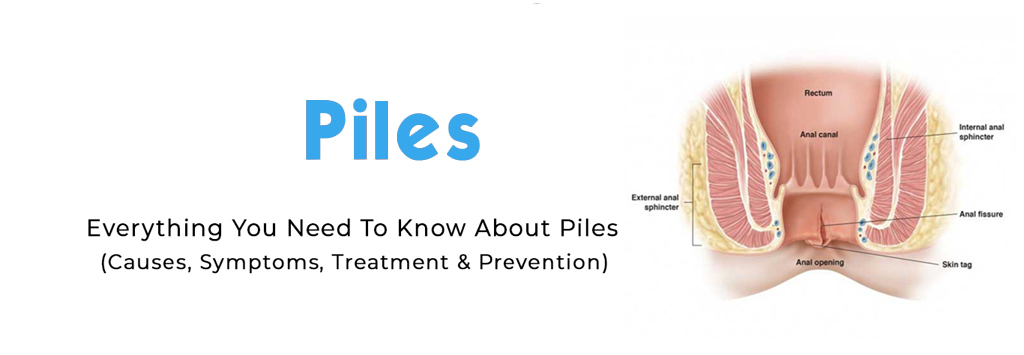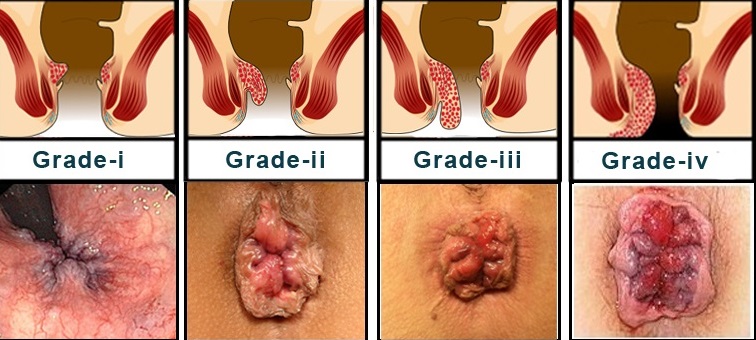
What are Haemorrhoids or Piles?
Haemorrhoids are one of the most common ailments. But most of the people suffer in silence rather than discuss with their doctor.
Haemorrhoids are varicose veins of the rectum or anus and are often called piles. These are actually enlarged bunch of blood vessels in and around the anus or rectum.
These generally develop over a period of time and come on during the middle and later stages of life, and especially during pregnancy. You may suffer from them, of course, when you are young but generally, they come on gradually from the age of about 30.
Piles can cause long-lasting discomfort, bleeding and be excruciatingly painful.
Types
These you cannot see or feel and the first indication you have them is when they bleed. Any bleeding of bright red blood from the back passage must be investigated as other causes are tumors and pathology of lower bowels.
In these the actual varicose veins hang out and can be very painful. They may not come out until you have a bowel movement and the pain associated with them will only be relieved if they are returned inside the anus or rectum. Prolapsed piles that stay out can strangulate. This produces an acute situation which can be very dangerous and is a medical emergency.
These lie outside the anal opening. They are masses of veins found underneath the skin at the anus. They cause itching, burning and irritation. When a blood clot form in an external pile, the skin around the anus becomes inflamed and a very painful lump develops. On rare occasions the clot will begin to bleed after a few days and leave blood on the under garments.
Diagnosis
 Physical examination of the anal canal by the doctor with the help of proctoscope.
Physical examination of the anal canal by the doctor with the help of proctoscope.- Sigmoidoscopy.
- Colonoscopy.
- Barium x-ray.
Massage in Haemorrhoids
This technique moves matter through the intestines, helping to prevent the constipation that contributes to piles.
Lie on your back, and use your fingers or your palm to make long, sweeping strokes. Repeat each stroke three to six times. Begin on your left side. Just below your ribs, stroke towards your feet; then stroke across your abdomen from the right to left just below your rib cage. Finally, point your fingertips towards your feet, and drag your hand up your right side from pelvis to ribs.
Diet & Nutrition
A diet adequate in fibre, consisting of fresh fruits, vegetables, whole-grain cereals and bran should be taken. Drinking 10 to 12 glasses of fluids daily is very important.
One should avoid diet rich in refined or junk foods.
A low-fibre diet or inadequate fluid intake causes constipation, which contributes to haemorrhoids in two ways: It encourages straining to have a bowel movement, and it also aggravates the piles by producing hard stools that further irritate the swollen veins.
Excessive salt in the diet causes fluid retention, which means swelling in all veins, including haemorrhoids.
Home Remedies
It is important to get into the habit of answering the CALL OF NATURE so that stools are passed easily without much strain.
Try not to sit for hours at a time. Take breaks and move around every hour for at least 5 minutes.
When performing any task that requires exertion, be sure to breathe evenly.
Regular exercise is also important, especially if you work a sedentary job. Exercise helps in several ways: Keeping weight in check, making constipation less likely, and enhancing muscle tone.
As you grow older it is wise to have a regular examination of your rectum and anus to eliminate the possibility of cancer or malignancy appearing in association with long-standing haemorrhoids.
Homeopathic Treatment
Before delving into homeopathic treatment let us first discuss the conventional or allopathic treatment available.
Modern medicine offers a range of ointments to treat haemorrhoids.
Monday to Saturday:
09.30am to 02.00pm
05.30pm to 09.30pm
Sunday:
09.30am to 02.00pm

